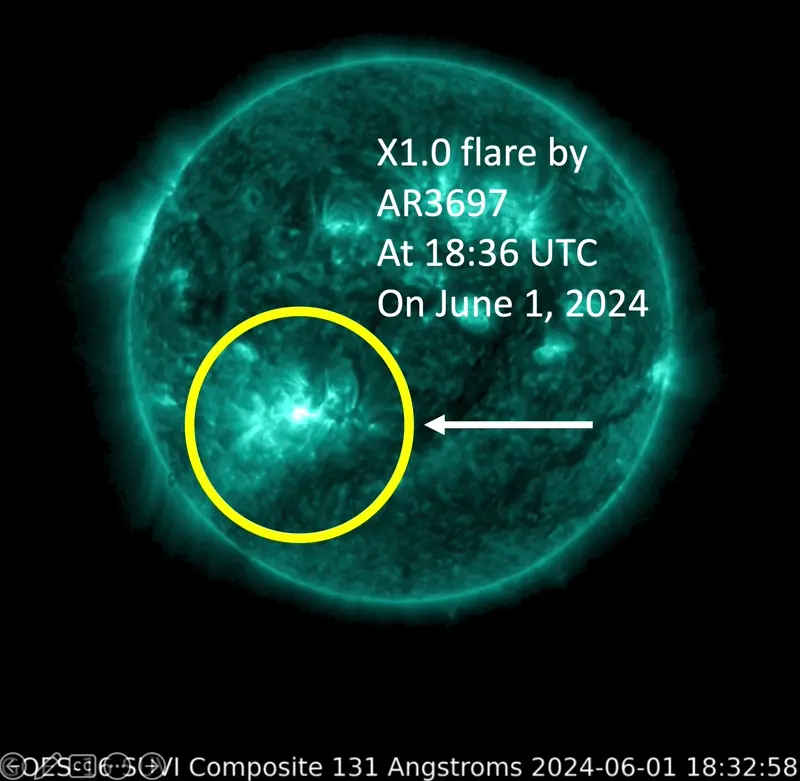
Sun news for June 2, 2024: BAM! Another X flare
Today’s top story: In the last 24 hours, the now-famous sunspot region AR3697 released another X flare. This X1.0 flare happened at 18:24 UTC on June 1. It caused an R3 (strong) radio blackout over the Americas. There was no significant coronal mass ejection (CME) observed with the X flare. But a lesser flare – an M7.4 flare around 19:01 UTC yesterday – did send something our way. Notice that this M flare came less than an hour after the X! AR3697 just keeps on ticking! Analysis is ongoing, but current estimates are for an Earth-directed CME and geomagnetic activity on June 3-4. Initial indications are for a G1 (minor)-G3 (strong) geomagnetic storm. That would mean auroral displays for higher latitudes at a minimum. We await confirmation of the forecast from NOAA’s Space Weather Prediction Center later today. Stay tuned.
Last 24 hours: Solar activity has remained high during the past day, thanks to AR3697’s X flare. During our observation period between 11 UTC yesterday to 11 UTC today, there were 23 flares: one X, four M flares, and 18 Cs. The largest was an X1.0 flare by AR3697 in the southeast at 18:24 UTC on June 1. This is the breakdown of the X and M flares:
– X1.0 by AR3697 at 18:24 UTC on June 1. R3 (strong) radio blackout over North America.
– M4.4 by AR3697 at 19:00 UTC on June 1. R1 (minor) radio blackout over the Americas.
– M7.4 by AR3697 at 19:01 UTC on June 1. R2 (moderate) radio blackout over the Americas.
– M1.2 by AR3697 at 04:41 UTC on June 2. R1 (minor) radio blackout over Asia.
– M2.0 by AR3697 at 08:40 UTC on June 2. R1 (minor) radio blackout over the Middle East.
The lead flare producer and producer of the largest flares was active region AR3697, which produced the X flare, four M flares, and 14 C flares. AR3697 maintained its beta-gamma-delta magnetic configuration, meaning it has the potential for more M and X flares. The sun currently has eight labeled sunspot regions on its Earth-facing side. Newcomers were numbered AR3700 and AR3701.
Next 24 hours: The chance for C flares is 99%. The chance for M flares is 75%. The chance for X flares is 35% today.
Next expected CME: An asymmetric halo coronal mass ejection (CME) associated with the M7.3 flare from June 1 was first visible in LASCO C2 imagery at 19:00 UTC, and it is expected to be Earth-directed. The final determination awaits the results of the analysis. No additional CMEs were observed in the available imagery.
Current geomagnetic activity: Earth’s magnetic field is quiet at the time of this writing (11 UTC on June 2). Quiet-to-unsettled conditions are expected for the rest of today, June 2. We await analysis of the halo CME associated with the June 1 M7 solar flare. Pending the results, the forecast for June 3–4 is likely to be for a G1 (minor) to G3 (strong) geomagnetic storm.
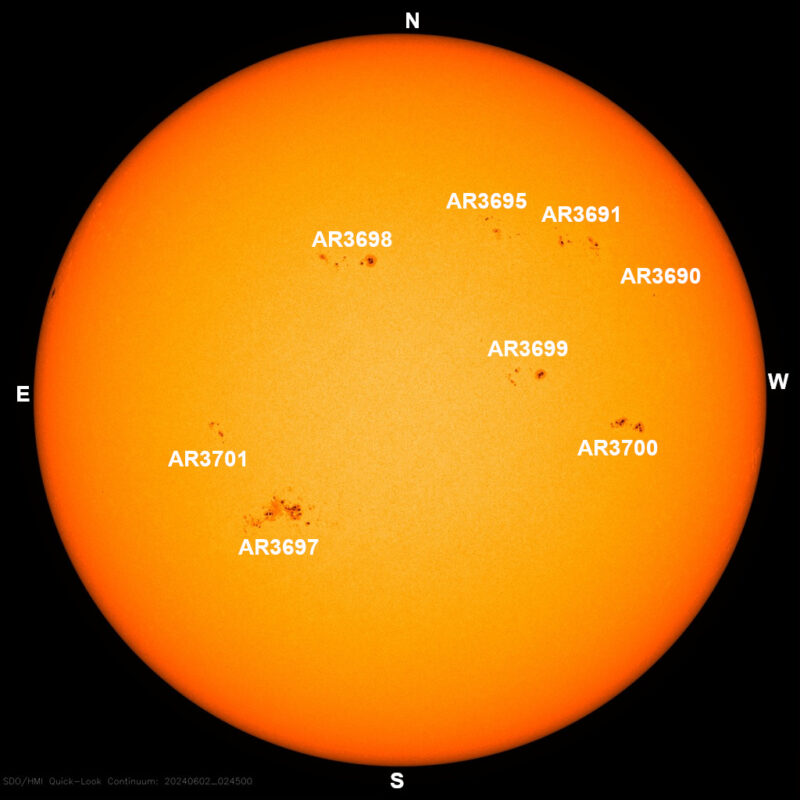
Sun news for June 1, 2024: Two X flares!
Giant active region AR3697 released two X flares during our observation period. First, the sun produced an X1.1 flare at about 22 UTC (5 p.m. Central) on May 31. An R3 (strong) radio blackout followed the blast, affecting an area over Hawaii. The second X flare was an X1.4 at 8:48 UTC on June 1. The blast caused an R3 (strong) radio blackout over Oman in the Arabian Peninsula. Not surprisingly, AR3697 was the lead flare producer of the day with two X flares, one M and six C flares. This giant sunspot region AR3697 (formerly AR3664, producer of the biggest flare of Solar Cycle 25 so far, an X8.8 on May 14) is now close to a geoeffective position. And that means any coronal mass ejections (CMEs) it produces have a better chance of affecting Earth’s magnetic field and possibly causing auroral displays. There are already auroral displays expected this weekend. The fastest CMEs can reach Earth in around 15 hours. Will a fast one come our way and give us a fantastic auroral display Saturday night? We await word from space weather forecasters about any coronal mass ejection produced during this event. Stay tuned.
Last 24 hours: Solar activity was high during the past day, thanks to AR3697’s two X flares. During our observation period between 11 UTC yesterday to 11 UTC today, there were 19 flares: two Xs, an M flare, and 16 Cs. The largest was an X1.4 flare by AR3697 in the southeast at 8:48 UTC on June 1. This is the breakdown of the X and M flares:
-M1.1 by AR3697 at 11:20 UTC on May 31. R1 (minor) radio blackout over Libya.
-X1.1 by AR3697 at 22 UTC on May 31. R3 (strong) radio blackout over Hawaii.
-X1.4 by AR3697 at 8:48 UTC on June 1. R3 (strong) radio blackout over Oman.
The lead flare producer and producer of the largest flares was active region AR3697, which produced the two X flares of the period, an M flare, and six C flares. In addition, AR3691 (former AR3663) produced six small C flares. Both regions AR3697 and AR3691 maintain their beta-gamma magnetic configuration, meaning they have the potential for more M and X flares. The sun currently bears seven labeled sunspot regions on its Earth-facing side. A newcomer was numbered AR3599.
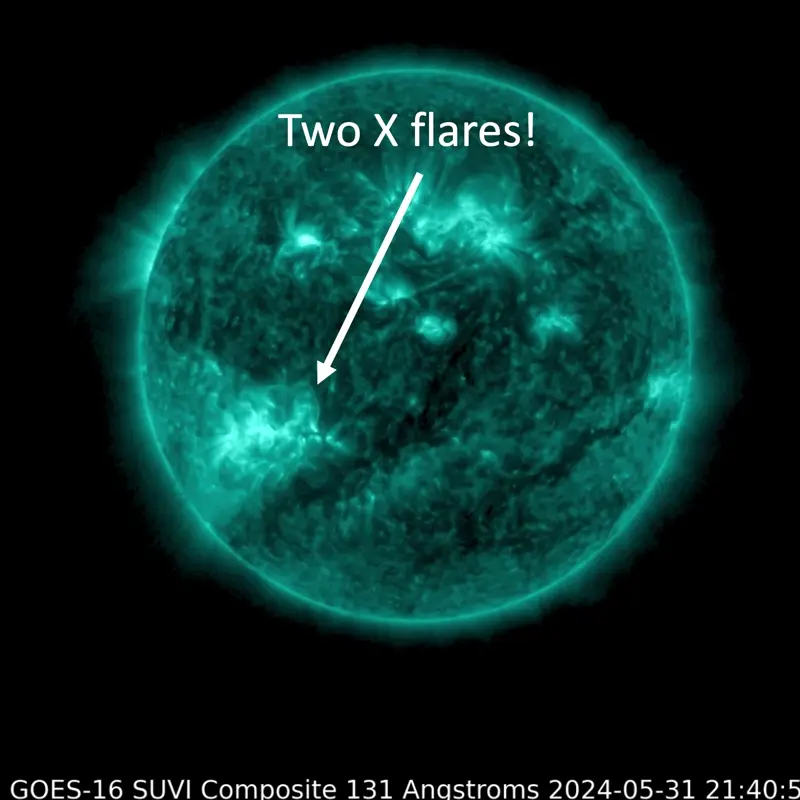
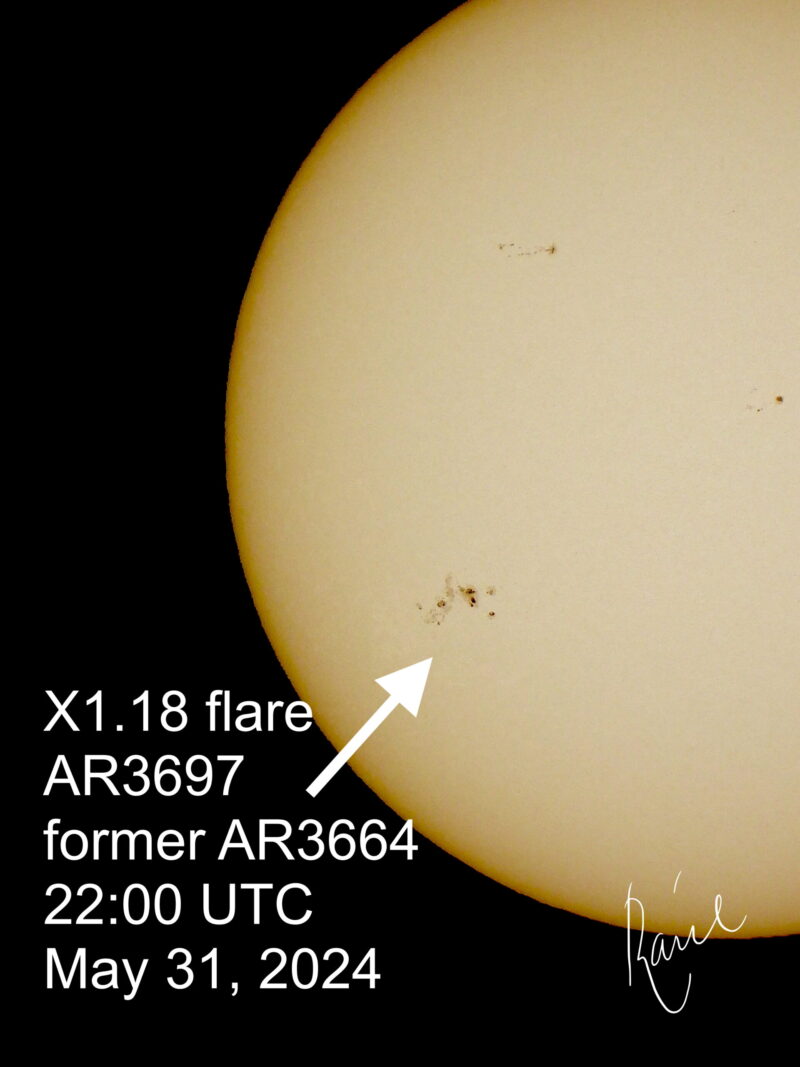
Sun news for May 31, 2024: Auroras possible tonight and tomorrow

Spaceweather experts are predicting auroras tonight and tomorrow! A G1 minor geomagnetic storm was registered at 5:18 UTC this morning. A coronal mass ejection (CME) hurled by the sun on May 27 – a bubble of solar material and magnetic fields – caused this morning’s storming. May 29’s X1.4 flare also gave us glancing blow from a CME, and it contributed to this morning’s storm, too. We also observed what looks like several small CMEs over the past day. And remember … the historic auroral display we saw back on May 10-11 was provoked by a series of small CMEs, which were swallowed up by a much larger and faster one on the way to Earth. Such incredible auroras aren’t expected this weekend … but if the sun keeps this up, it could only take one big flare from returned sunspot region AR3697 – which was largely responsible for the May 10-11 solar storm – to bring some more major geomagnetic storming. Stay tuned!
Last 24 hours: Solar activity would be moderate if we included the M1.1 flare that took place 20 minutes after our observation period ended (our observation period is 11 UTC yesterday to 11 UTC today; the M flare was at 11:20 UTC this morning). Prior to that, we saw only C flares over the past day, 13 in all. The largest was a C9.8 flare – almost an M flare – by AR3697 in the southeast at 3:37 UTC on May 31. We also saw a large solar filament that started lifting plasma. This is the kind of event that eventually ends in a huge prominence, so we’ll keep watching. The lead flare producer of the period was AR3697, which blasted out seven flares, followed by AR3698 with five. AR3697 maintains its beta-gamma magnetic configuration, meaning it has the potential for more M and X flares. Meanwhile, AR3691’s magnetic complexity reduced to the lower-potential beta-gamma. The rest of the seven labeled sunspots on the solar disk remain either stable or in decay. There’s a newcomer in the northeast, now numbered AR3698.

Sun news for May 30, 2024: Another X flare from returning monster sunspot!

X flare! Giant sunspot AR3697 (formerly AR3664) blasted out an X1.4 flare yesterday, its second X flare since rotating back onto the Earth-viewed sun. It was a long-duration eruption that peaked at 14:37 UTC on May 29. An R3 (strong) radio blackout was registered from 14:25 to 16:54 UTC, initially affecting an area over the mid-Atlantic Ocean and ending over Puerto Rico. The flare sent a coronal mass ejection, or bubble of solar material and magnetic fields, into space. AR3697 is still near the eastern horizon, so the CME will not provide a direct hit, but initial analysis suggests a component may give Earth a glancing blow late tomorrow.
Last 24 hours: Sun activity is high after the X flare. 12 flares were produced between 11 UTC yesterday and 11 UTC today: one X flare, six Ms, and five Cs. The largest was an X1.4 flare from AR3697 at 14:37 UTC on May 29.
The list of X and M flares for the day is:
-M1.9 flare by AR3695 at 11:21 UTC on May 29. R1 (minor) radio blackout over Algeria in Africa.
-M2.5 flare by AR3697 at 12:55 UTC on May 29. R1 (minor) radio blackout over the west coast of Africa.
–X1.4 flare by AR3697 at 14:37 UTC on May 29. R3 (strong) radio blackout over the mid-Atlantic Ocean. (The largest)
-M2.7 flare by AR3691 at 18:28 UTC on May 29. R1 (minor) radio blackout over Mexico.
-M5.7 flare by AR3691 at 18:41 UTC on May 29. R1 (minor) radio blackout over Mexico.
-M1.3 flare by AR3691 at 19:10 UTC on May 29. R1 (minor) radio blackout over the Pacific Ocean off the west coast of Mexico.
-M1.1 flare by AR3691 at 7:13 UTC on May 30. R1 (minor) radio blackout over India.
The lead flare producer of the period was AR3691, with five flares: four Ms and one C flare. Active regions AR3691 and AR3697 are the largest in area on the solar disk. Both have a beta-gamma magnetic configuration. This means they have the potential for more M and X flares. The sun currently has seven labeled active regions on its Earth-facing side.
Active Region 3697 (former AR3664) just blasted out an X1.4 flare! Read more at https://t.co/EifSzAdFFq.#sun pic.twitter.com/EAEmQ1137g
— EarthSky (@earthskyscience) May 29, 2024
Sun news for May 29, 2024: A former giant sunspot is back!
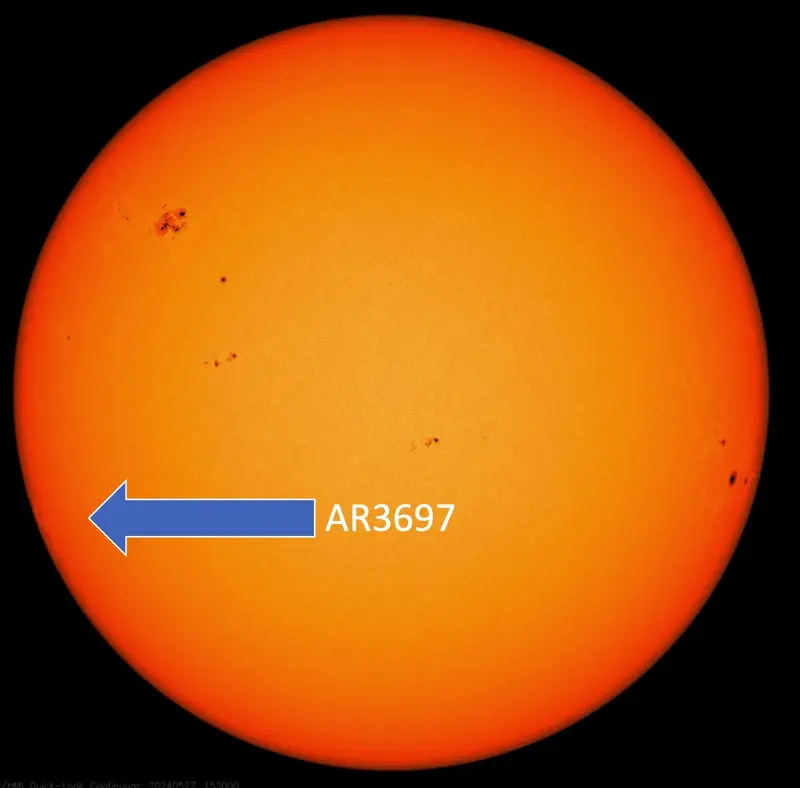
The monster active region AR3664 is back on the Earth-facing sun, now labeled AR3697. The sun’s rotation has carried it back into view. And what an entrance! It was apparently the source of yesterday’s X2.9 flare, seen before the region had come fully into view over the solar horizon. Today, the region is still close to the sun’s southeast limb (edge). So a full analysis isn’t possible yet. But it appears that – during its transit on the far side of our star – this region decayed a bit. It’s still big, but not as big as it was. It’s showing a beta-gamma magnetic configuration. And it’s putting out flares. This region brought today’s sun activity level up to moderate, by producing two M flares. It’s today’s lead flare producer, with 18 total flares. Details below. During its past incarnation as AR3664, it produced 11 X flares from May 6 to May 14. It was the producer of the largest X flare of Solar Cycle 25 so far, an X8.8 on May 14. And it was a main player in the huge geomagnetic storm we experienced on May 10. Let’s see what it’s got to offer this time.
Last 24 hours: Sun activity is now moderate. During our observation period (11 UTC yesterday to 11 UTC today), the sun produced a total of 21 flares, two Ms and 19 C flares. The largest was an M1.5 flare by active region AR3697 at 6:45 UTC on May 29. Shortly after the explosion an R1 (minor) radio blackout was registered, affecting an area over India. The other M was an M1.2 by AR2697 at 1:06 UTC on May 29. This time, the corresponding R1 (minor) radio blackout affected an area over the Pacific Ocean. Lead flare producer of the period is prolific AR2697, which blasted out 18 flares, the two mentioned Ms plus 16 C flares. Currently, the sun has eight labeled active regions on its Earth-facing side.
Sun news for May 28, 2024: X2.9 flare yesterday
And we’re back, after two days off for the Memorial Day weekend. While we were out, the sun blasted an X2.9 flare at 7:08 UTC on May 27. It came from an incoming active region on the sun’s southeast limb (edge). Presumably, the producer is the former large sunspot region AR3664, still located behind the solar horizon. In the two days before this X flare, the sun was quiet, with not even a single M flare (moderately sized flare). There were only little C flares. Then early yesterday, boom! This unexpected X flare. Since then, it’s been quiet again. The X flare provoked an R3 (strong) radio blackout, affecting an area over the Arabian Sea. And it produced a huge prominence, with a large partial halo registered by SOHO’s LASCO C2 and C3. The coronal mass ejection (CME) produced during the event is not coming our way at Earth. But a bit of its shock wave could sideswipe Earth today. Keep tuned for more sun news.
Last 24 hours: Note that the X flare happened just outside our ordinary observation period (11 UTC yesterday to 11 UTC). Thus, over the past day, solar activity was considered low. But the sun produced a lot of little flares, 17 C flares in all. The largest was a C9 at 19:16 UTC on May 27 from the incoming active region on the sun’s southeast, presumably the former AR3664. This active region, unnumbered as yet, has been quite productive. It blasted out 13 C flares out of the day’s 17 flares. Meanwhile, its former companion – formerly labeled AR3663, now AR3691 – has been quiet, producing only a few C flares during the weekend. But AR3691 is still is the largest active region in physical size on the Earth-facing solar disk. Currently, the sun has eight labeled active regions on its Earth-facing side.
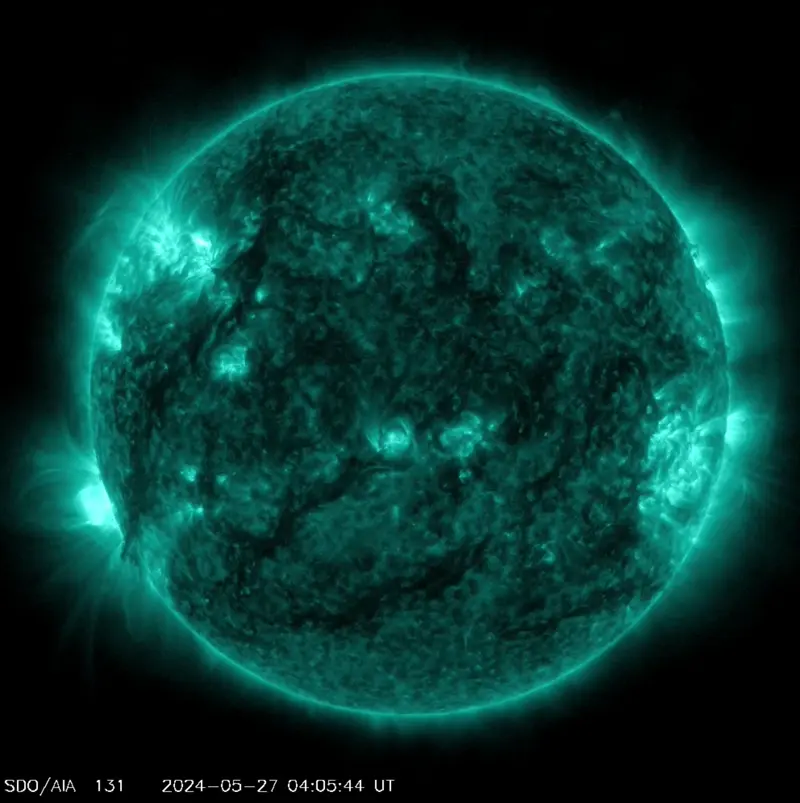
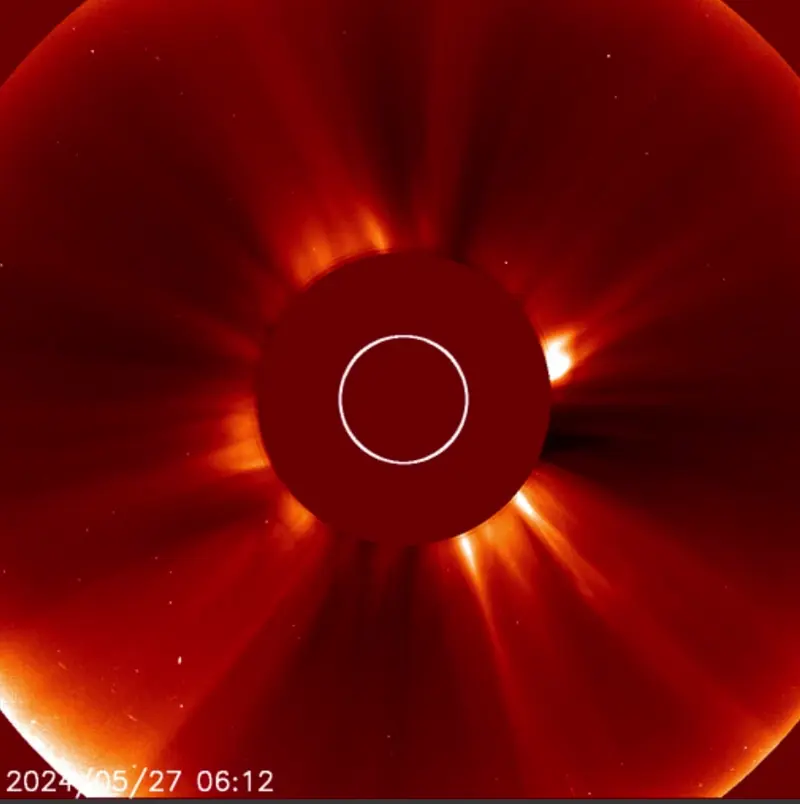
The sun in recent days

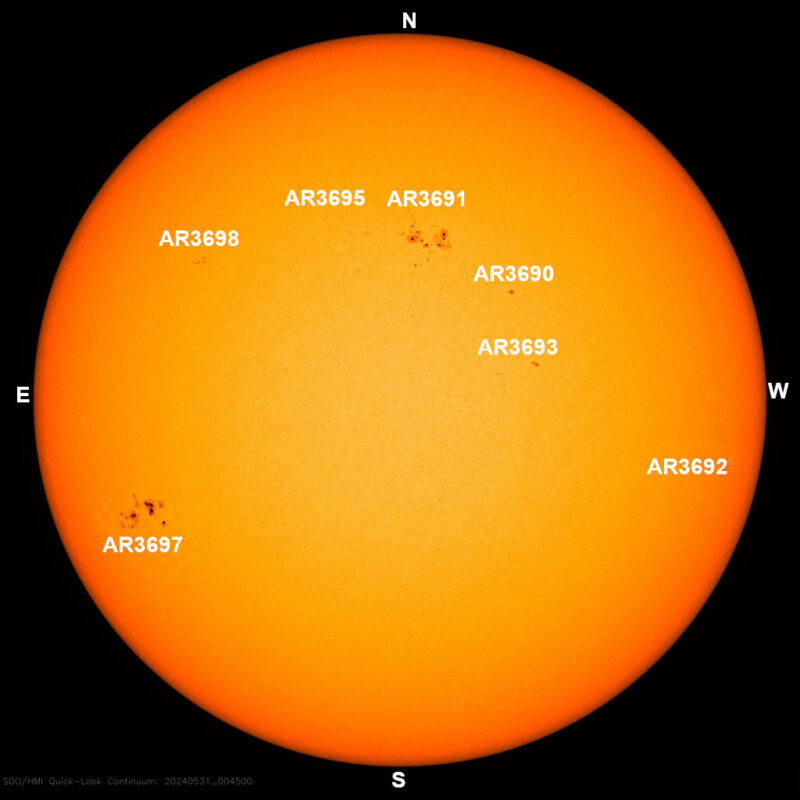
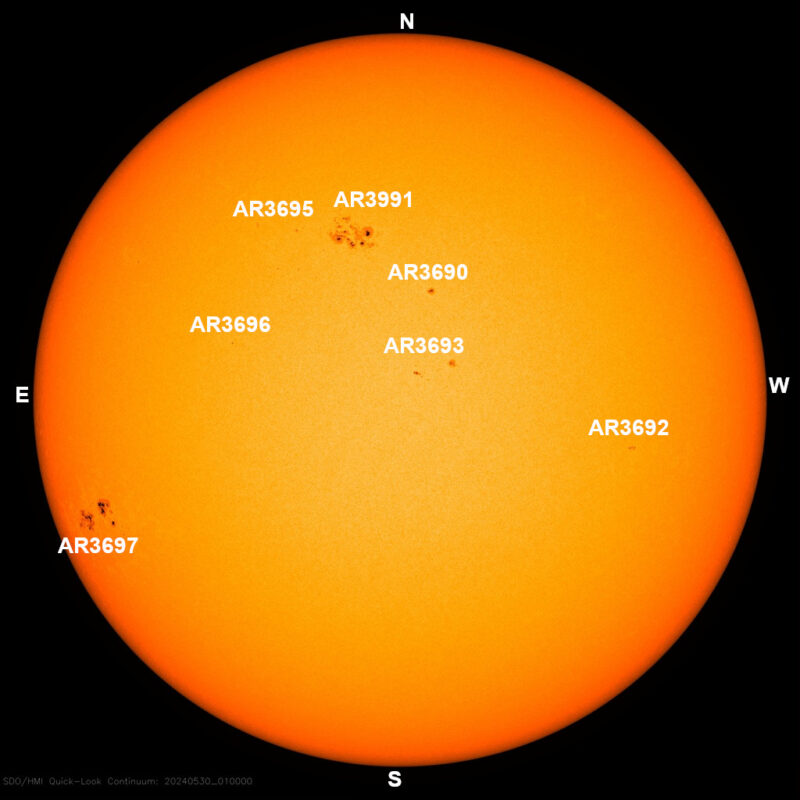
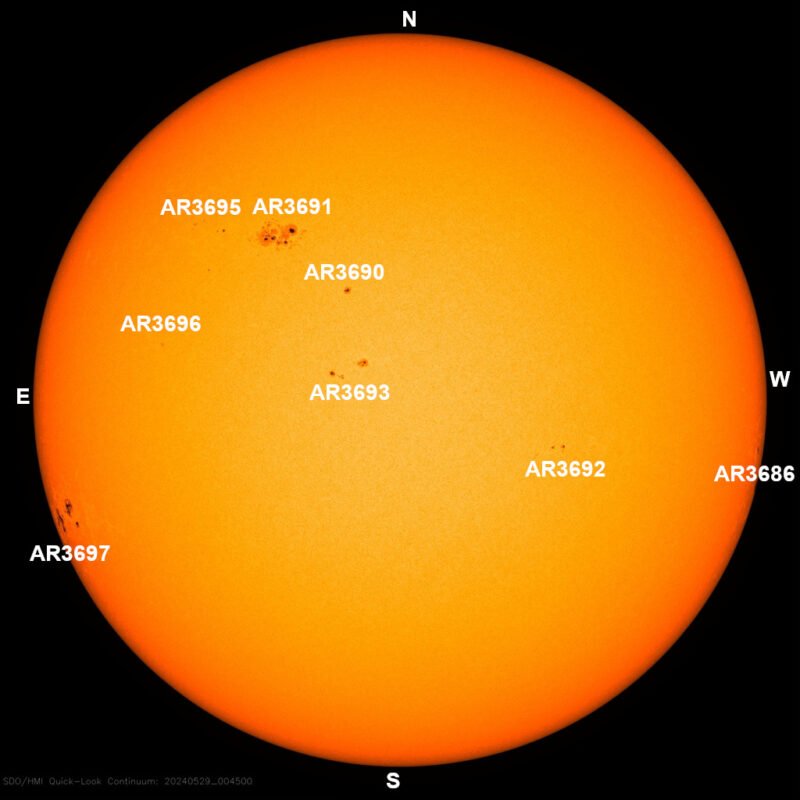

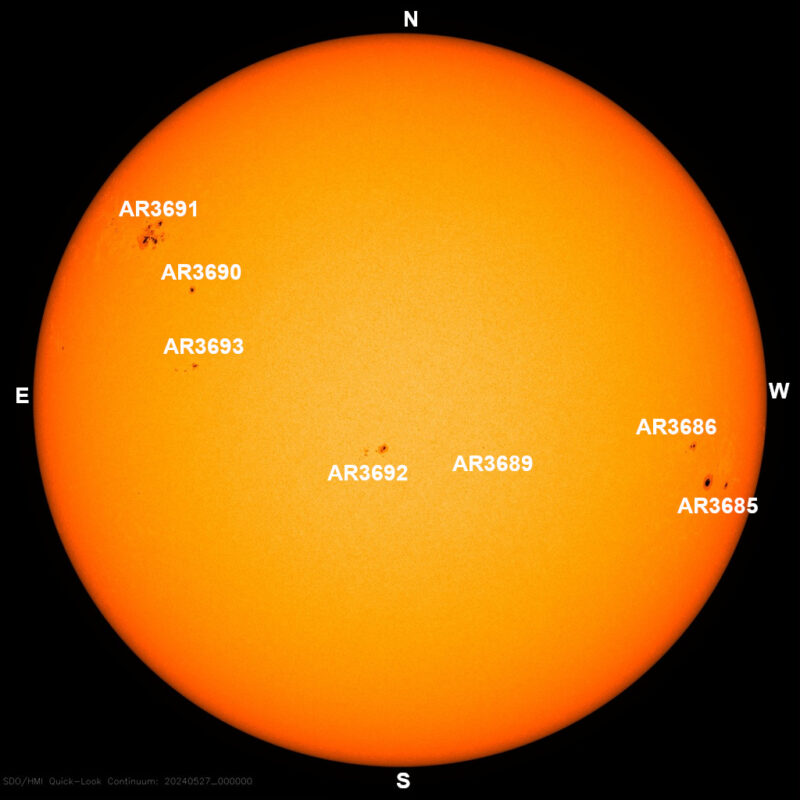
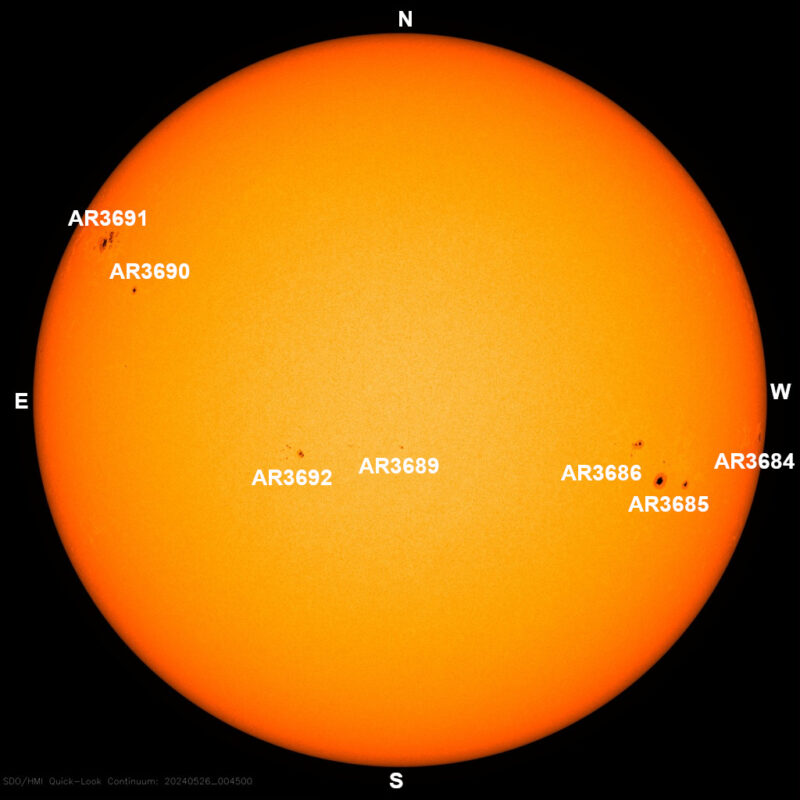
Sun images from our community
Are you a fan of sun images? We invite you all to send us your beautiful recent photos of sunspots and auroras. We love receiving them and sharing them! And to those of you who’ve already posted a photo to our community page, thank you.
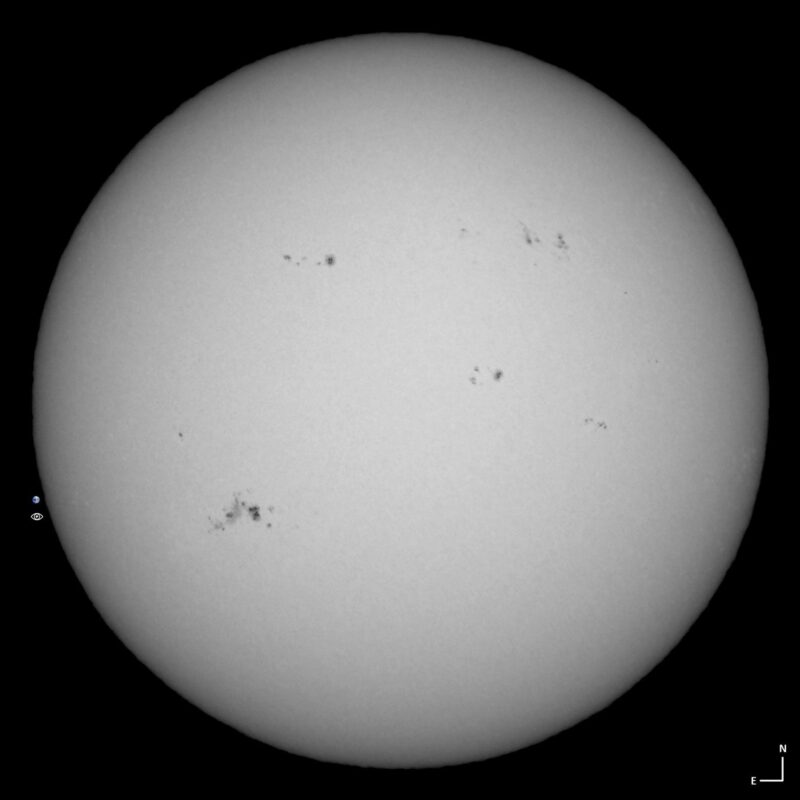
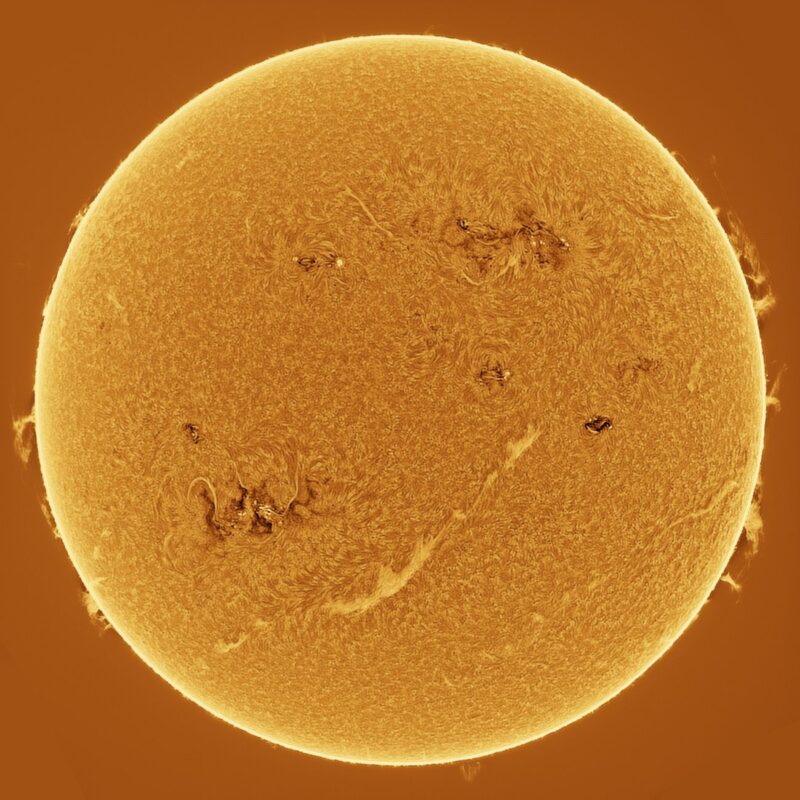
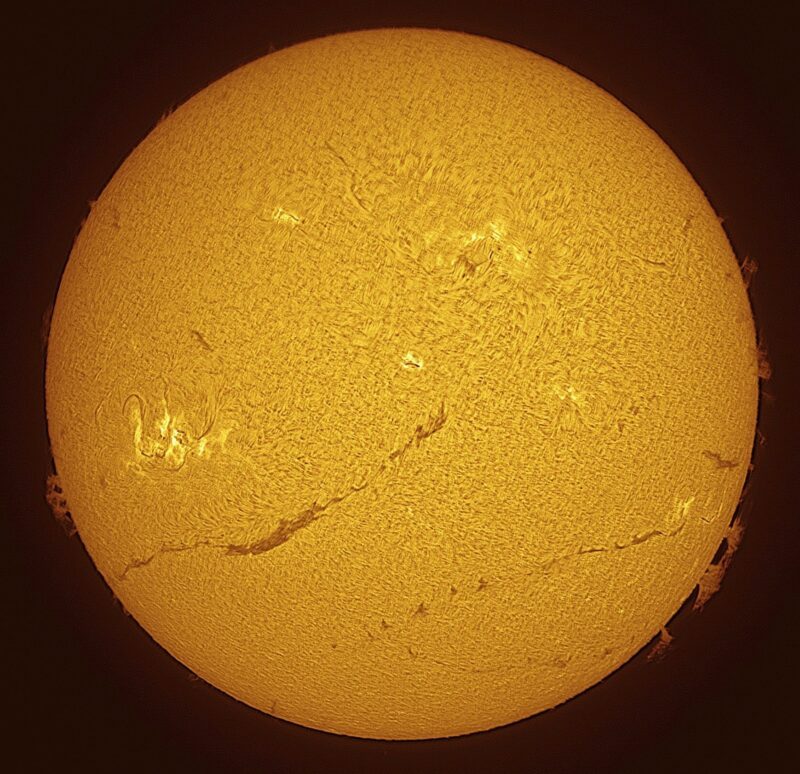

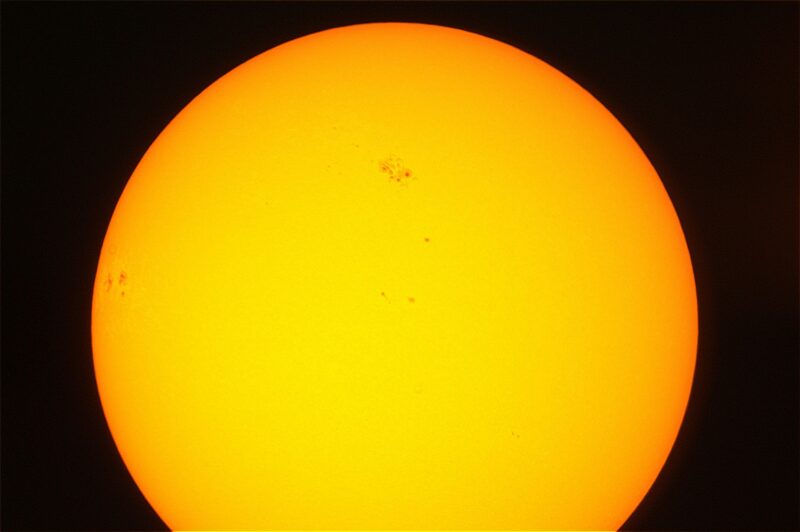

Bottom line: Sun news for June 2, 2024: Following two X flares in the previous 24 hours, AR3697 produced another one, an X1. Geomagnetic conditions are quiet to unsettled now, but might increase in intensity tomorrow.











